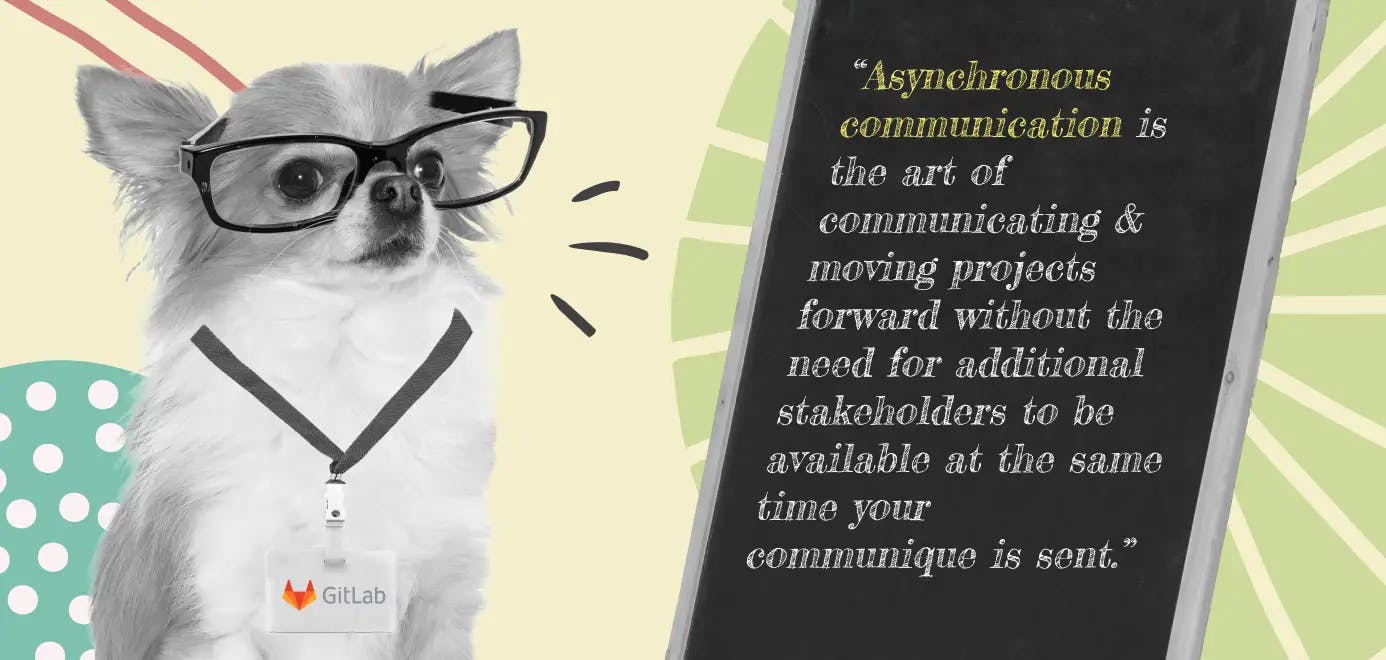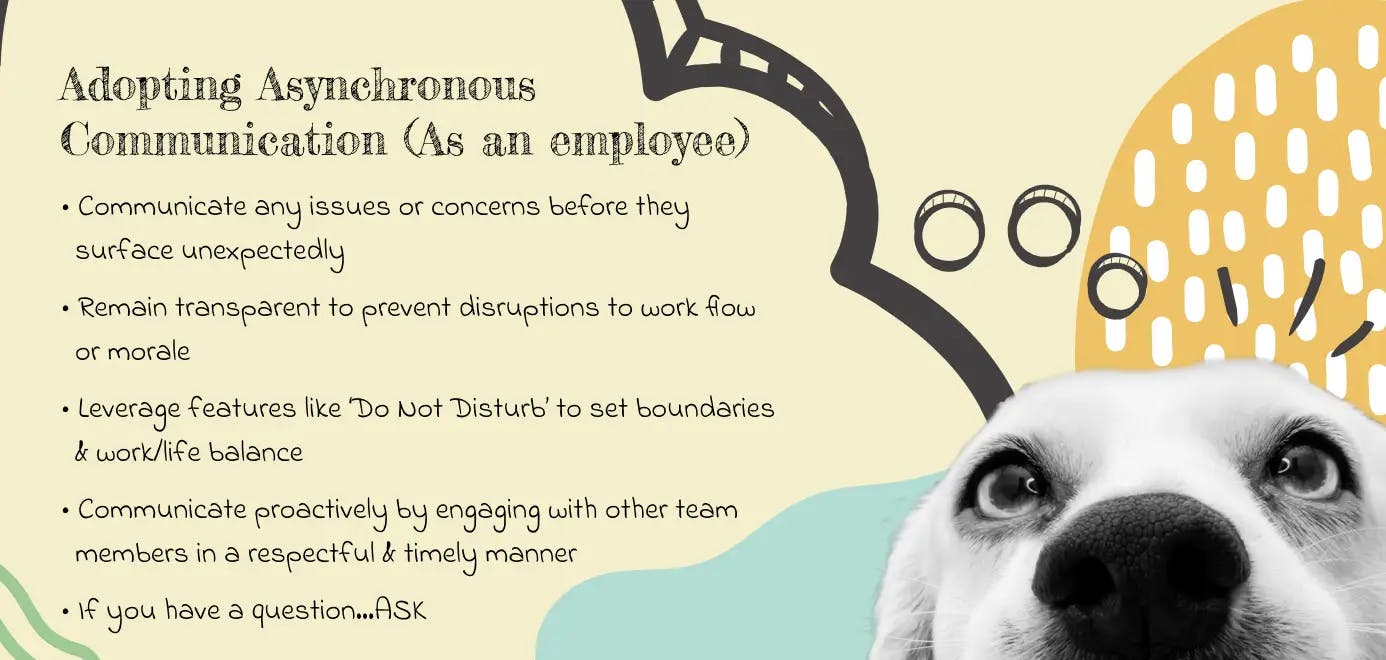The unanimous shift towards a hybrid remote work structures in 2020 has also brought asynchronous communication to the forefront. Which is awesome because devs love async.

Many of us have found ourselves trading corporate desktops for kitchen countertops. Existing in such a world in which we dutifully risk cabin fever to avoid a real one, it begs the age-old question, “How can organizations most effectively balance productivity without disrupting inclusivity?”
While the concept of operating remotely isn’t particularly new, working from home has invited an amalgam of processes to help manage internal communication as well as promote a heightened sense of work/life balance.
In this article we will explore the details behind Asynchronous Communication. You will learn when to use asynchronous vs synchronous communication efforts, how to hire asynchronously, and the challenge you can expect when making the asynchronous communication transition.
Defining Asynchronous Communication
A structure widely adopted by distributed organizations long before 2020, this method of communication enables teams to collaborate outside parameters bound by linear time constraints.

What is Asynchronous Communication?
“Asynchronous communication is the art of communicating and moving projects forward without the need for additional stakeholders to be available at the same time your communique is sent.” According to GitLab
Based entirely in text, asynchronous communication leverages the transient nature of apps like Slack or Asana to host discussions that colleagues can weigh in on at a time that makes the most sense for their schedules.
Flexible by design, team members no longer have to interrupt a project to pick up their kids late from daycare, just to sit in on a call that could have easily been an email. It instead allows them to say “Hey, I’m having childcare issues and have to be offline this afternoon; but will log on at 7pm to review.”
Now, this is what we call… say it with me…work-life balance.
A sentiment that’s become increasingly blurred throughout the years, it’s now more important than ever to respect online and offline hours when working from home…

When to Communicate Asynchronously
Asynchronous communication is most appropriate for exchanging information that doesn’t require urgent attention. Initiatives such as daily stand up or relatively straightforward (or boring) discussions, are often more productive through a text-based channel.
Oh, and about those time zones…
No longer is it necessary to align the Australia team with colleagues in New York just to hop on another Zoom call that could easily be transcribed in a chat app. Rather than restrict productivity to a specific set of time zones, employees are instead held accountable for completing their work on their own time.
Now, before you think you’re off the hook for another meeting…not so fast.
Sure the shift from 9-to-5 to 9-to-5g has come with its own set of terms; however, eliminating meetings altogether isn’t yet one of them. While async communication is an effective way to exchange information without interruption, there are circumstances that are better suited for conversations in real time.
When to Communicate Synchronously
I recently caught up with Cate Huston, current Director of Engineering for Mobile at DuckDuckGo, and who also just so happens to be a distributed dev team expert. Boasting roughly 100 employees and growing, Cate’s company was fully remote prior to Covid; so, she knows a thing or two about managing team members who are all operating out of different locations.
Check out Cate's episode of the Dev Interrupted podcast

When discussing async communication, Cate didn’t dismiss meetings entirely. In fact, synchronous communication can be a highly effective way to develop rapport and promote a heightened sense of team bonding.
Diffusing arguments or engaging in contentious topics that could potentially fuel a debate are also better-suited to take place synchronously. A good example of this might be architectural review, sprint planning or what to eat for lunch (depending on how hungry you are.) The immediacy of a synchronous meeting allows teams to ‘hash it out’ or come to a resolution for time-sensitive initiatives.
Combining Synchronous and Asynchronous Communication
We recognize that not all discussions can be hosted in one style or another. Take a sprint planning meeting for example. Rather than spend most of the meeting discussing topics that could easily be addressed in an email; cut the discussion in half to deliver the more straightforward information through a text-based channel. By aggregating content that the team already agrees on, you can help promote a more productive conversation about topics that actually need to be addressed in real time.

Boost efficiency even further by providing a list of actionable items ahead of the call which clearly outline topics of discussion. This gives attendees a chance to review and prepare their own talking points and questions that may arise before they even join the meeting.
I mean, who wants to scramble to ask a question and put their public speaking skills on display in front of the whole company anyway? (Certainly not 22-year old Dan) Not only is this more time effective, but it’s also a great way to jumpstart a more productive conversation.
3 Needed Traits for Asynchronous Communication New Hires
When interviewing remote candidates, you’ll want to consider factors that extend beyond just their skills and relevant experience. From communication skills to coachability, it’s crucial that employees possess the traits required to work asynchronously.

Strong Communication & Writing Skills
Strong communication and writing skills are a must-have when working within an asynchronous environment. Regardless of their position, potential hires need to be able to articulate themselves clearly and in a timely manner.
To determine whether or not a candidate is a good fit for your remote team, pay attention to exchanges throughout the entire process beginning with their initial cover letter and application. Sloppy emails or delayed response times may be an indication that this person isn’t best suited for the role.
Self-Motivated
Solutions-oriented individuals are ideal candidates for asynchronous environments. Unlike a traditional office structure, employees can’t simply turn to their neighbor and ask for help with their question. Instead, they must take initiative to solve the problem on their own, especially if they’re unable to connect with someone immediately after sending a message.
Coachability
It’s important that candidates are adaptable to new processes and changes that come with working remotely. Asynchronous communication is a collaborative effort and employees who can’t shift their mentality from a traditional synchronous style are more than likely a poor fit for your team.
How to Successfully Adopt Asynchronous Communication
Transitioning to a fully remote structure is an adjustment by itself; and even more so if your team was forced into the situation overnight. But as with any new system being put into place, success rests upon facilitating it properly and with intention. It’s the responsibility of the entire organization to maintain an open line of communication that helps to not only set expectations for each other, but adhere to ones set forth for themselves.
Review Your Calendar
Now there are a few different ways to escape the proverbial wall of real-time communication and endless meetings. One of the first steps is by auditing your calendar’s current meetings and removing the ones that can be replaced through a text-based exchange. (PSA: Let the other attendees know you’re removing the meeting, rather than simply not showing up.)
A/B Test Different Styles
Cate’s team at DuckDuckGo adopts an experimental mindset. Her team begins each week by choosing experiments they want to try. For example, one team member might say they don’t think a 2-hour sprint planning meeting is effective. They’ll be asked to introduce an alternative and with buy-in from the team, give it a try to see how it goes.
Not only is this a great way to discover alternative ways to work together, but it also helps to promote team culture and company morale. In fact, Cate actually considers the failed experiments a win. By working as a team to address pain points and creatively explore solutions, you’re helping to cultivate a heightened sense of team loyalty and respect for one another.
Recompiling Your Rituals
From daily stand ups to sprint planning meetings, all teams have their routine rituals that they rely on for consistency, organization and even comfort. And while structure is necessary to run a smooth ship, it may be necessary to revisit these rituals to determine what’s working, what’s not and what could actually be hurting your progress as a team.
Not to drop another sailing reference on you, but we’re navigating uncharted waters here in 2020. What may have worked last year could very well require an adjustment that aligns with the landscape we’re currently operating within.
Manager / Employee Responsibilities
To ensure success when transitioning to an Asynchronous Communication style both the employee and manager need to keep these points top of mind:

As an Employee
Communicate any issues or concerns before they surface unexpectedly Remain transparent to prevent disruptions to work flow or morale Leverage features like ‘Do Not Disturb’ to set boundaries and preserve work/life balance Communicate proactively by engaging with other team members in a respectful and timely manner If you have a question…ASK

As a Manager
Set expectations such as response timeframes and respectful communication Operate by a uniform set of guidelines to prevent any misunderstandings Make an effort to expand your awareness and pick up on the intangibles; as its harder to notice red flags when communicating through text Go beyond just surface items during one-on-one meetings to check-in emotionally Reiterate to your team that you can only raise so much awareness without transparency on their end Set availability or turn on ‘Do Not Disturb” to protect your own work/life balance
The Dreaded Zoom Call
Video calls have served as a replacement for our daily in-office exchanges. However, with hours of calls throughout the day, it’s becoming more and more common for employees to suffer from Zoom exhaustion. As organizations continue to acclimate to remote work, it could be time to reconsider whether these calls are benefiting productivity or deterring it.
Can information from these virtual meetings be exchanged asynchronously? How long are these calls and how many are team members sitting on each day? Is it productive for all attendees to be included on the calls just because they were originally invited to sit in on in-person meetings? While we may have never considered these questions 9 months ago, we’re operating in a different world today. Paramount to the success of your organization and your team’s mental health, it’s important to reevaluate how we’ve aligned pre-asynchronous rituals with our current environment.
Set Expectations
If not the most important element of transitioning to an asynchronous environment, be sure to always set expectations. We are talking about communication, afterall. Messages can be sent or read at any time so establish timeframes that offer employees a guideline they can adhere to. Reinforce best practices to help your team acclimate to an asynchronous style, such as maintaining transparency and setting boundaries.
Don’t forget that this is a structure designed to reduce stress boost flexibility, and optimize productivity. So with the right tools, outlook and understanding, you can trust that your team won’t just exist, they’ll thrive when operating within an asynchronous environment.
3 Challenges with Asynchronous Communication
Keep in mind that the asynchronous architecture is intended to streamline communication and boost productivity. However, as with anything, there may be challenges especially for newly remote organizations looking to adopt this style of communication.

Lost in Translation
It goes without saying that messages exchanged through a text-based channel are more susceptible to becoming lost in translation. It’s human nature to imply tone so it’s critical that teams working asynchronously learn how to overcome this. ( As a bonus, it might even help outside of work when messaging with your mother-in-law.)
The biggest way to prevent misunderstandings is by promoting mindful communication. Since people inherently apply tone to messages, take time to teach employees how to receive messages as well as construct them in a way that isn’t too direct or comes off curt.
Sense of Urgency
Async comm doesn’t imply a sense of urgency; which is why it’s not appropriate for any exchange that requires immediate attention. If you’re on a deadline or need information at that very second, then find another way to communicate with your team members to get the information you need, when you need it.
Lack of Emotional Transparency
One of the biggest disadvantages is the lack of transparency that comes with exchanging messages across a text-based channel. When you’re communicating in-person, it’s easier to decipher tone or recognize that a team member is overwhelmed. However, when operating asynchronously, you may need to go out of your way to check in on someone.
As Donald Kuth once said ever so eloquently, “Computers are good at following instructions, but not at reading your mind.”
Dev Interrupted Discord
Cate and hundreds of other dev leaders in the Dev Interrupted Discord community talk every day about async communication and other issues effecting dev teams right now. We would love for you to join us and weigh in.


